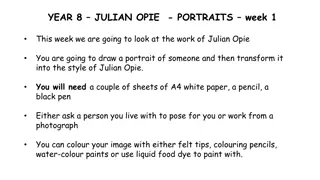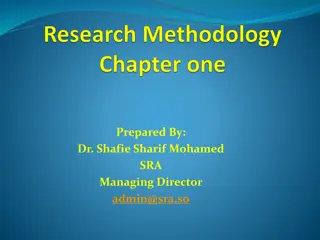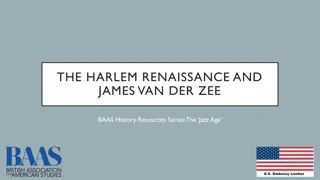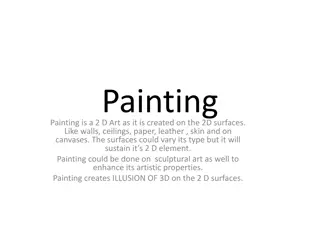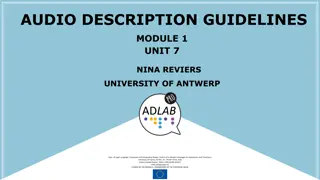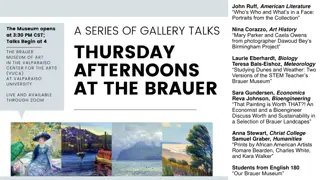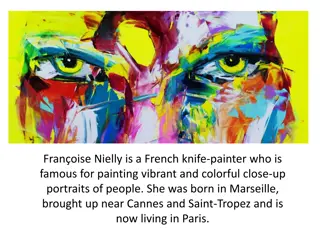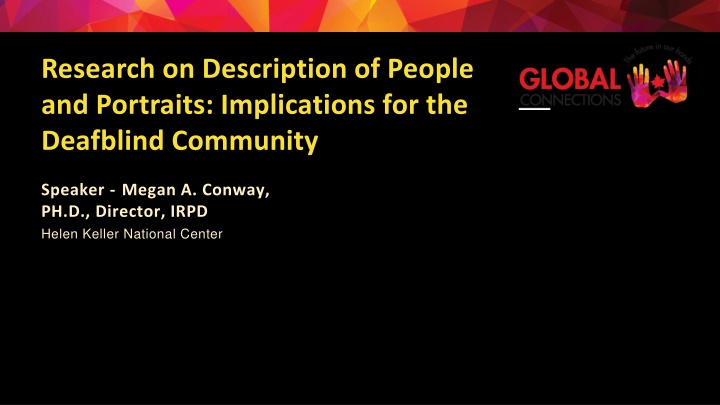
Implications of Audio Descriptions for the Deafblind Community
Explore the implications of audio descriptions for individuals in the Deafblind community through research conducted by Megan A. Conway, PH.D. The study focuses on preferences related to describing people and portraits, highlighting the importance of factors like facial expression, age of onset, and direct visual source descriptions. Findings underscore the need for tailored audio description practices that cater to the unique needs of Deafblind individuals, emphasizing relevance, respect for self-identification, and ongoing feedback for enhanced experiences.
Download Presentation

Please find below an Image/Link to download the presentation.
The content on the website is provided AS IS for your information and personal use only. It may not be sold, licensed, or shared on other websites without obtaining consent from the author. If you encounter any issues during the download, it is possible that the publisher has removed the file from their server.
You are allowed to download the files provided on this website for personal or commercial use, subject to the condition that they are used lawfully. All files are the property of their respective owners.
The content on the website is provided AS IS for your information and personal use only. It may not be sold, licensed, or shared on other websites without obtaining consent from the author.
E N D
Presentation Transcript
Research on Description of People and Portraits: Implications for the Deafblind Community Speaker - Megan A. Conway, PH.D., Director, IRPD Helen Keller National Center
Background Study conducted on audio description preferences of people and portraits. Focus on race, gender, age, disability Audio description (AD) provides visual information Various media and other contexts Lack of research=Limited understanding of preferences Especially for people who are DeafBlind
Methodology Five focus groups and two interviews with 15 blind, low vision, and DeafBlind participants. Recruitment: listservs, Blinded Veterans Association, and American Council of the Blind. Participant Demographics: 15 participants (9 men, 5 women, 1 non-binary) Diverse racial backgrounds 10 identified as DeafBlind
Findings and Implications for DeafBlind Participants Importance of facial expression Impact of age of onset Describing directly from the visual source Integration of sound and sight to create a whole picture Taking an educated guess.
Other Findings Context around AD provision Self-identification of person being described On-going communication between AD providers and users
Conclusion Audio description preferences may be different for DeafBlind people Importance of relevance, respect for self-identification, and continuous feedback for improved AD experiences Further research and development of guidelines for diverse representation
This Has Been a Presentation by the Helen Keller National Center This power point is the property of HKNC. Please do not copy, distribute or reuse. For more information contact Megan Conway at mconway@helenkeller.org Or go to www.helenkeller.org

![READ [PDF] Portraits in Time](/thumb/42216/read-pdf-portraits-in-time-powerpoint-ppt-presentation.jpg)



